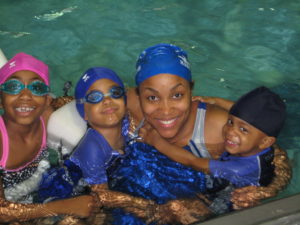By: Angela Beale, Ph.D.
American Red Cross Scientific Advisory Council
As a mother of four young children and an aquatics education specialist, I know first-hand that there’s nothing kids love more than a trip to the pool.
But did you know that the Consumer Product Safety Commission (CPSC), Centers for Disease Control and Prevention (CDC), and World Health Organization (WHO) recently reported that children ages 1-4 and younger represent about 76 percent of all pool and spa drowning deaths? Additionally, did you know that of injuries treated in the United States emergency rooms about 78 percent were pool and spa related injuries?
Put another way, when kids don’t know swim-safety basics, also known as water competency, it’s like having a shark in the pool.
So what do kids need to know? The American Red Cross calls swimmers “water competent” if they can:
1. Step or jump into the water over their heads and return to the surface.
2. Swim 25 yards (equal to the length of a standard swimming pool) without stopping.
3. Float or tread water for 1 minute without using a flotation device.
4. Turn around in a full circle in the water and then find a way out of the water.
5. Exit a pool, not using a ladder.
If your kids can’t complete every one of these key skills, now is the time to get into the swim of things and register them for an American Red Cross swim class.
Just remember that every child is special and even children who can perform all five of these critical water safety skills need supervision. If you host kids in a backyard pool or at a recreational pool, be sure to follow these guidelines:
* Eyes on the Prize: Constantly supervise children near water. Many children who drown in home pools were out of sight for less than five minutes and in the care of parents at the time.
* Fence It: If you have a pool, secure it with appropriate barriers.
* It’s On You: Never trust a child’s life to another child; teach children to always ask permission to go near water.
* Stay Focused: Avoid distractions when supervising children around water.
* First and Fast: If a child is missing, check the water first. Seconds count in preventing death or disability. Get Involved and Get Educated: Take the Online Home Pool Essentials class from the Red Cross and National Swimming Pool Foundation® (NSPF).
About the Author: Angela Beale, Ph.D. is a member of the American Red Cross Scientific Advisory Council and Aquatics Subcouncil with a specialty in physical education and youth development. The Council is a panel of nationally recognized experts drawn from a wide variety of scientific, medical, and academic disciplines. The Council guides the Red Cross on emergency treatments and practices that align with the latest evidence-based scientific and medical knowledge.

